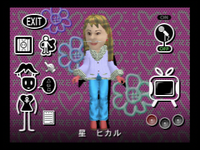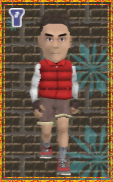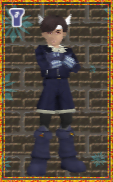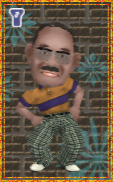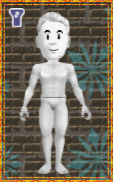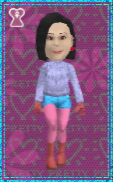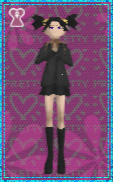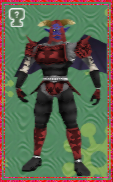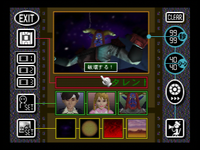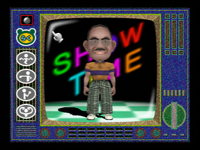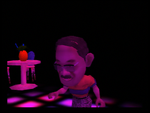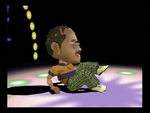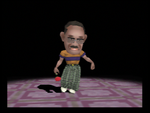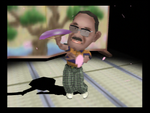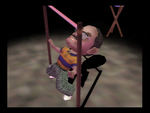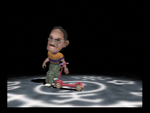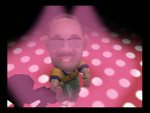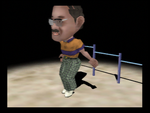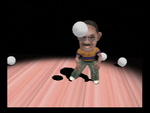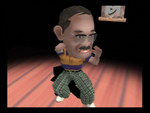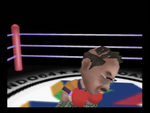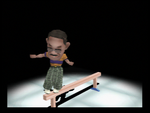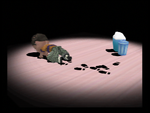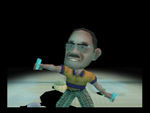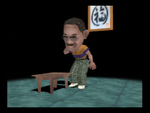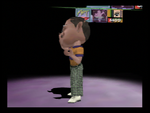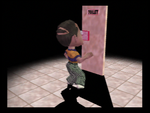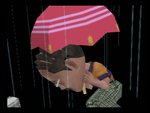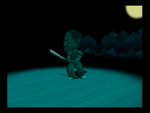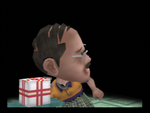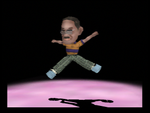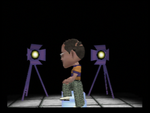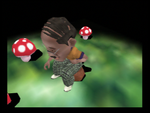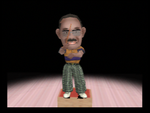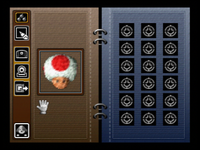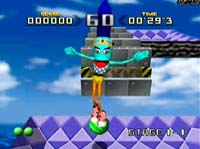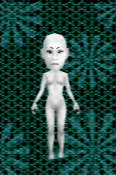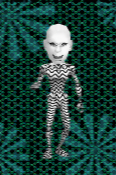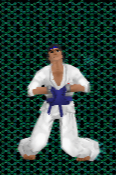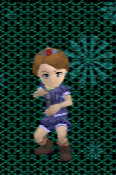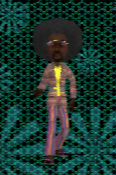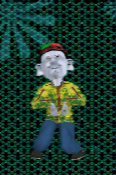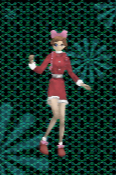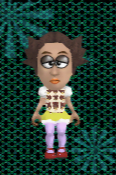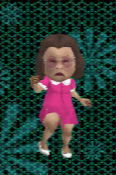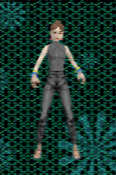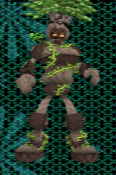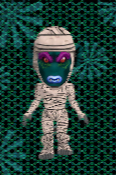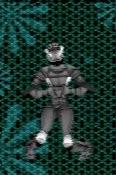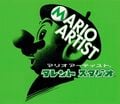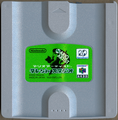Mario Artist: Talent Studio
| Mario Artist: Talent Studio | |
|---|---|
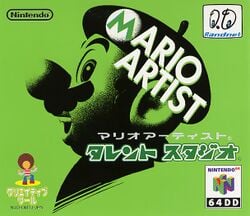
| |
| Developer | Nintendo R&D1 |
| Publisher | Nintendo |
| Platform | 64DD |
| Release date | |
| Genre | Creative |
| Mode | Single player |
| Format | 64DD:
|
| Input | Nintendo 64:
|
| Serial code | NUD-DMTJ-JPN |
Mario Artist: Talent Studio[2] is a Japan-only game released on February 1, 2000 for the 64DD, as part of the Mario Artist series.[1] It was one of the few games released for the system.
The main feature is the creation of characters known as "talents",[3] whom the player can put into different animations, such as the talent dancing or doing sports. There are many customizable features for the talents, such as body style, size, face, hair, clothes, bio, voice, and more. Talents can also be used as characters for movies, another major feature of the game. Using the bundled Capture Cassette or a Game Boy Camera, the player can import faces and other images by running a video camera through it.
Mario Artist: Talent Studio is one of only two 64DD games to use the Transfer Pak, alongside Mario Artist: Paint Studio.
Gameplay[edit]
Controls[edit]
| Action(s) | Input(s) |
|---|---|
| Move cursor | |
| Select buttons and options | |
| Rotate or zoom into a talent Back |
|
| Move cursor to exit button | |
| Undo | |
| Move the screen | |
| Act as the |
1 - Can be configured in the options menu
Modes[edit]
Mario Artist: Talent Studio features two main modes: Talent o Tsukuru (「タレントをつくる」, "Create a Talent"), which allows the player to create a 3D talent character and customize them, and Movie o Tsukuru (「ムービーをつくる」, "Create a Movie"), where the player can create and edit a movie by using the previously created talents. Another mode accessible from the main menu is Sakuhin o Miru (「さくひんをみる」, "View Works"), where the player can view their saved talents on a stage or their saved movies in a custom-made playlist.
Talent o Tsukuru[edit]
Talent o Tsukuru is a mode where the player can create virtual avatars named "talents". The player can choose sample types, including just their bodies, and also play animations with them in the Show Time (「ショータイム」, Shō Taimu) mode. By connecting the Nintendo 64 Microphone, it is also possible to record a one-second long voice clip. There are several customization options available:
- Rinkaku nado (「りんかくなど」, "outlines, etc."): Allows customizing the talent's face shape, hair, nose, ears, and facial hair. The player can also give the talent a helmet, hat, glasses, earrings, and small items. Their color and pattern can also be changed.
- Kao/hada no iro (「かお・はだのいろ」, "face/skin color"): Allows customizing the talent's face and skin color. The face can be customized either by using preset textures for eyebrows, eyes, lips, and more or by importing images with the Capture Cassette or a Game Boy Camera. 2D creations from Mario Artist: Paint Studio can also be imported. The player can also give the talent lipstick and modify their expressions. Up to eight faces can be saved in the Kao Album (「かおアルバム」, "Face Album").
- Koe (「こえ」, "voice"): Allows customizing the talent's voice by making it feminine or masculine or changing its pitch.
- Fukusō/style (「ふくそう・スタイル」, "clothing/style"): Allows customizing the talent's clothing and body height/shape. The clothing options include swimsuits, tights suits, shirts, pants, socks, shoes, gloves, and accessories, and can have their color and pattern changed.
- Talent no namae (「タレントのなまえ」, "talent's name"): Allows changing the talent's name, occupation, gender, birthday, age, favorite line, and write some information.
Sample talents[edit]
豪 マサル
(Gō Masaru)勇者ルイ
(Yūsha Rui)ハル
(Haru)車 大吉
(Kuruma Daikichi)星 ヒカル
(Hoshi Hikaru)モモ姫
(Momo-hime)アイコ
(Aiko)桜田 ウメ
(Sakurada Ume)E〜坊
(E~Bō)魔王
(Maō)うさぎ
(Usagi)車 烏子
(Kuruma Karasuko)
Movie o Tsukuru[edit]
Movie o Tsukuru is a mode that allows the player to create a short movie by using their saved talents and backgrounds. The player can either edit existing sample movies ("Talent Quest", "Hotcake", and "SPEED") or create one from scratch. Movie backgrounds can be added by using sample ones or by importing one (via the Capture Cassette, a Game Boy Camera, or Mario Artist: Paint Studio). In addition to using talents, players can also use sample 3D models as props or import them from Mario Artist: Polygon Studio. A robust movie editor can be accessed to add scenes, effects, music, sounds, and captions. The maximum length a movie can be is 99 seconds, while the maximum amount of scenes is 50.
Show Time[edit]
Show Time is a mode in Talent o Tsukuru where the player can play animations featuring their talent. The animations are divided into four categories: odoru (「おどる」, "dancing"), sports (「スポーツ」, supōtsu), seikatsu (「せいかつ」, "life"), and iroiro (「いろいろ」, "various"). Each category has seven animations. In most animations, the player can press ![]() /
/ to cause an effect. The player can also press
![]() to make the talent do a noise.
to make the talent do a noise.
Animations[edit]
- Odoru
- Sports
- Seikatsu
- Iroiro
Moyō Album[edit]
Moyō Album (「もようアルバム」, "Pattern Album") is a mode in Talent o Tsukuru, accessible while customizing a talent's face features and clothing. The player can save up to 18 patterns and import new ones with the Capture Cassette, a Game Boy Camera, or from Mario Artist: Paint Studio. With the Moyō o Tsukuru (「もようをつくる」, "Create a Pattern") option, players can access an editor to edit the currently-selected pattern.
Staff[edit]
- Main article: List of Mario Artist: Talent Studio staff
Pre-release and unused content[edit]
Pre-release footage of Talent Studio (under the early title Talent Maker) includes gameplay of a minigame which was removed from the final game. The minigame would have involved controlling the player's talent on a green ball and completing a series of stages while under a time limit. Purple gems were also collectable in the stages and awarded points to the player.[4]
Two unused options in Talent o Tsukuru exist in the code of the final game. The first option, named Show Time Edit (「ショータイムエディット」, Shō Taimu Editto), would have allowed the player to edit the properties of Show Time animations, including the background, camera, lighting, and "graffiti". The second option, named Pose o Erabu (「ポーズをえらぶ」, "Choose a Pose"), would have allowed the player to choose one out of five poses for their talent.[5]
A prototype of Talent Studio, dated August 5, 1999, was dumped on September 2025. The prototype features an early interface for Talent o Tsukuru which only allows the player to edit the talent's face, face items, voice, and clothes/body shape. In addition, it features a completely different set of sample talents, all replaced in the final game. The prototype also has an unfinished interface for Movie o Tsukuru which includes some scrapped backgrounds such as artwork of Sherbet Land, Toad's Turnpike, DK's Jungle Parkway, and Banshee Boardwalk from Mario Kart 64 and music tracks like "Underground BGM" from Super Mario Bros.[6]
Prototype sample talents[edit]
元モデル2
(Moto Moderu)
2 - Two variants of this talent can be found in two containers in the Save and Load menu, with one variant having the name「元モデルょ」(Moto Moderu yo).
Gallery[edit]
Mario artwork
A photo of the Mario Artist series demonstration event at Nintendo Space World '99, where the game was demonstrated
Screenshots[edit]
References to other games[edit]
- The first six notes of "Ground BGM" from this game can be used as a music track for movies.
- Sound effects from this game can be used as sounds for movies.
- Artwork of Koopa Troopa Beach from this game can be used as a background for movies.
Names in other languages[edit]
| Language | Name | Meaning | Notes |
|---|---|---|---|
| Japanese | マリオアーティスト タレントスタジオ[7] Mario Ātisuto Tarento Sutajio |
Mario Artist Talent Studio | |
| Dutch | Mario Artist: Talent Studio[8] | - | |
| French (NOE) | Mario Artist: Talent Studio[9] | - | |
| German | Mario Artist: Talentstudio[10] | Mario Artist: Talent Studio | |
| Italian | Mario Artist: Talent Studio[11] | - | |
| Portuguese (NOE) | Mario Artist: Talent Studio[12] | - | |
| Spanish (NOE) | Mario Artist: Talent Studio[13] | - |
Notes[edit]
- Kazumi Totaka's song appears in this game as a music track that can be used in movies. This specific arrangement would later be adapted into "K.K. Song" from the Animal Crossing series.
References[edit]
- ^ a b Sakai, Kazuya (Ambit), et al. (October 19, 2015). 『スーパーマリオブラザーズ百科: 任天堂公式ガイドブック』(Super Mario Bros. Hyakka: Nintendo Kōshiki Guidebook). Tokyo: Shogakukan (Japanese). ISBN 978-4-09-106569-8. Page 243.
- ^ Iwata Asks - Vol 4: Sound, Design and Planning. Iwataasks.nintendo.com. Retrieved May 6, 2023.
- ^ In-game English name in the Sakuhin o Miru menu
- ^ VideoGameEphemera (May 20, 2025). Nintendo Space World 1997 B-Roll Complete (12:17). YouTube (Japanese). Retrieved November 1, 2025.
- ^ Mario Artist Talent Studio § Unused Modes. The Cutting Room Floor. Retrieved November 1, 2025.
- ^ LuigiBlood (September 20, 2025). Mario Artist Talent Studio (1999-08-05 Prototype) Showcase. YouTube. Retrieved November 1, 2025.
- ^ Box art
- ^ Iwata vraagt: 1. Van Zelda tot Wii Fit. Nintendo (Dutch). Retrieved October 31, 2025. (Archived July 10, 2025 via Wayback Machine.)
- ^ Iwata demande: 1. De Zelda à Wii Fit. Nintendo (French). Retrieved October 31, 2025. (Archived July 10, 2025 via Wayback Machine.)
- ^ Iwata fragt: 1. Von Zelda zu Wii Fit. Nintendo (German). Retrieved October 31, 2025. (Archived July 8, 2025 via Wayback Machine.)
- ^ Iwata Chiede: 1. Da Zelda a Wii Fit. Nintendo (Italian). Retrieved October 31, 2025. (Archived July 10, 2025 via Wayback Machine.)
- ^ Iwata Pergunta: 1. De Zelda a Wii Fit. Nintendo (Portuguese). Retrieved October 31, 2025. (Archived July 10, 2025 via Wayback Machine.)
- ^ Iwata Pregunta: 1. De Zelda a Wii Fit. Nintendo (Spanish). Retrieved October 31, 2025. (Archived July 10, 2025 via Wayback Machine.)
External links[edit]
| Mario Artist: Talent Studio | ||
|---|---|---|
| Talents | Samples | Aiko • E~Bō • Gō Masaru • Haru • Hoshi Hikaru • Kuruma Daikichi • Kuruma Karasuko • Maō • Momo-hime • Sakurada Ume • Usagi • Yūsha Rui |
| Communication Kit | Akira-chan • Banchō • Dai-chan • Fuku-chan • Gon • Han • Hana no Sei • Ichirō • Jūdan • Kōichi-kun • Kōji • Mori no Sei • Runrun • Sanosuke • Shōichi • Warui Hito A • Yuki | |
| Others | Hiroshi Yamauchi | |
| Movies | Samples | "Hotcake" • "SPEED" • "Talent Quest" |
| Communication Kit | "Ame Tokidoki..." • "Boku no Banchō" • "Ume★Dance" | |
| Others | "Shachō kara no Goaisatsu" | |
| Other | Staff | |
| Nintendo 64 games | |
|---|---|
| Super Mario franchise | Super Mario 64† (1996) • Mario Kart 64† (1996) • Mario no Photopi (1998) • Mario Party (1998) • Mario Golf (1999) • Mario Artist: Paint Studio* (1999) • Mario Party 2 (1999) • Mario Artist: Talent Studio* (2000) • Mario Artist: Communication Kit* (2000) • Mario Tennis (2000) • Paper Mario† (2000) • Mario Artist: Polygon Studio* (2000) • Mario Party 3 (2000) • Dr. Mario 64† (2001) |
| Donkey Kong franchise | Diddy Kong Racing (1997) • Donkey Kong 64 (1999) |
| Yoshi franchise | Yoshi's Story† (1997) |
| Crossovers | Super Smash Bros.† (1999) |

